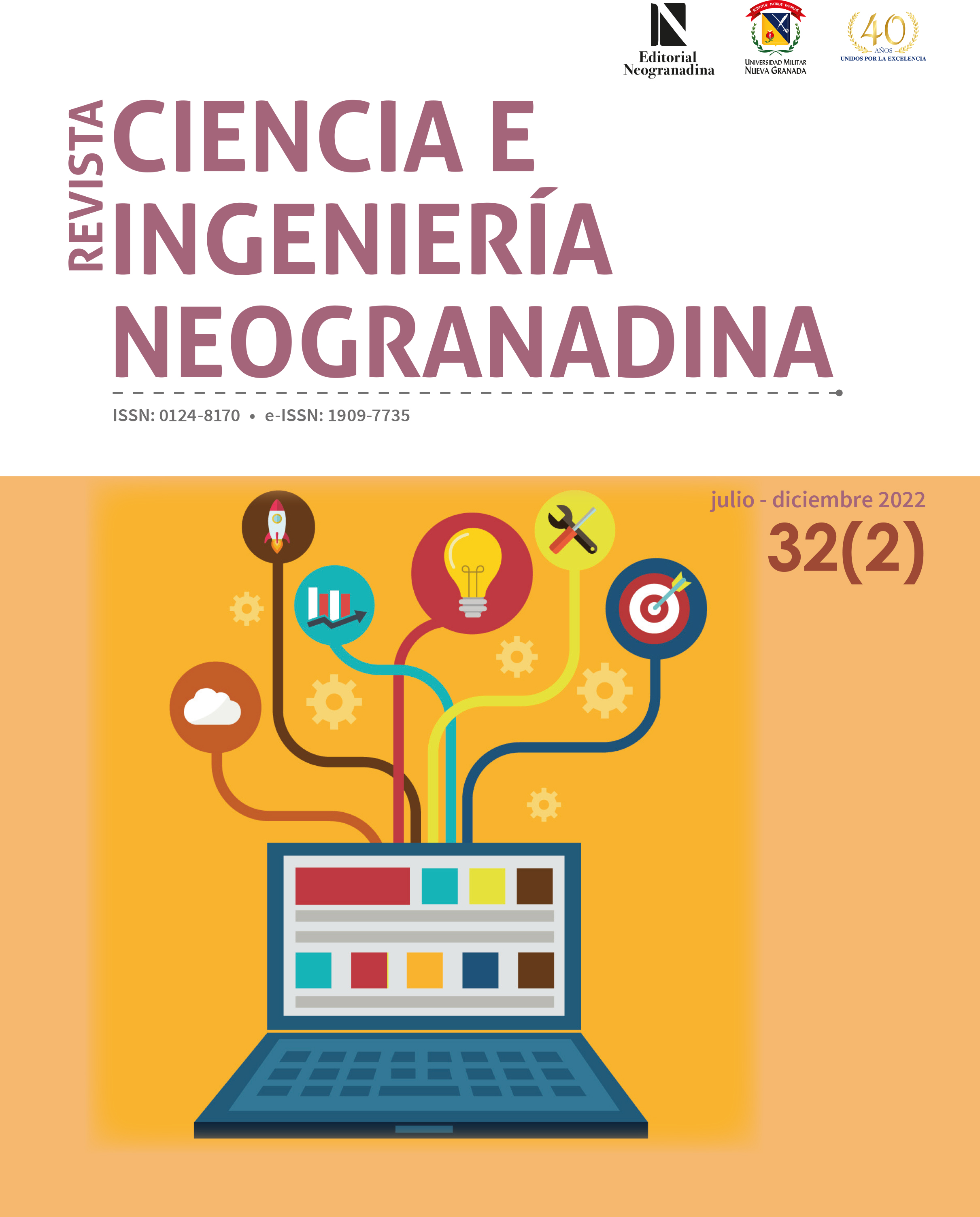Experimental validation of an analytical method for mass ground motion monitoring using fiber-optic sensors
Abstract
In this article, we present the implementation of a system for mass ground motion monitoring consisting of a soil profile prototype, a photonic sensor network based on Bragg gratings, and an interrogation system. The soil prototype was reproduced using polymeric materials representing the soil layers generally involved in landslide events. The sensor network consisted of inclinometers composed of cylindrical fiberglass rods instrumented with photonic sensors based on Bragg gratings, evenly distributed over the soil prototype. The interrogation system itself was composed of an interrogator device used to capture the information yielded by the sensors in the form of Bragg wavelength deviations, whose values were subsequently related to the deformations of the inclinometers by means of a signal processing algorithm, to yield motion detection results. The experimental results show that the implemented analytical algorithm can generate a vector indicating the direction of an eventual mass ground motion from the measurement of deformations in the implemented optical inclinometers with an average error of 3°. According to the low error levels obtained, it is demonstrated that the proposed photonic sensor network is a promising tool for landslide monitoring oriented to the reduction of the socioeconomic effects caused by natural disasters.
Downloads
References
M. Marulanda, Atlas de Riesgo de Colombia: Revelando los desastres latentes, Bogotá: Unidad Nacional para la Gestión del Riesgo de Desastres, 2018.
L. Mejía, Índice municipal de riesgo de desastres de Colombia, Bogotá: Departamento Nacional de Planeación, 2018.
R. Puyana, La agenda de cambio climático en Colombia y el rol del financiamiento, Bogotá: Departamento Nacional de Planeación, 2018.
R. Suárez, Análisis del gasto público y privado e institucionalidad para el cambio climático-Caso de Colombia, Bogotá: Comité de Gestión Financiera del Sisclima, 2018.
UNGRD, Colombia, un país con múltiples amenazas geológicas, pero ¿por qué sucede esto?, en la UNGRD se lo explicamos, Bogotá: Unidad Nacional para la Gestión del Riesgo de Desastres, 2020.
R. Luis et al., "Comparación de metodologías para la estimación de riesgos de movimientos en masa", Revista Técnica de Maquinaria y Obra Pública, vol. 71, 2018. [Internet]. Disponible en https://www.obrasurbanas.es/metodologias-riesgos-movimientos-masas/
J. Vásquez et al. "La avenida torrencial de Mocoa, Putumayo ¿ejemplo de una retrospectiva sin punto final en la gestión del riesgo de desastres detonados por eventos naturales?", Revista de Derecho, vol. 50, 2018. https://doi.org/10.14482/dere.50.0007
DNP, Sistema de monitoreo, reporte y verificación de financiamiento climático, Bogotá: Departamento Nacional de Planeación, 2018.
C.-Y. Tsou et al., "Topographic and Geologic Controls on Landslides Induced by the 2015 Gorkha Earthquake and its Aftershocks: an Example from the Trishuli Valley, central Nepal", Landslides, vol. 15, n.° 5, 2018, pp. 953-965. https://doi.org/10.1007/s10346-017-0913-9
R. Kenner et al., "Monitoring Mass Movements using Georeferenced Time-Lapse Photography: Ritigraben Rock Glacier, Western Swiss Alps", Cold Regions Science and Technology, vol. 145, 2018, pp. 127-134, https://doi.org/10.1016/j.coldregions.2017.10.018
B. Andò et al., "A Magnetic Fluid-Based Inclinometer Embedding an Optical Readout Strategy: Modeling and Characterization", IEEE Transactions on Instrumentation and Measurement, vol. 69, n.° 8, 2020, pp. 5922-5929, https://doi.org/10.1109/TIM.2020.2964937
P. Confuorto et al., "Monitoring of Remedial works Performance on Landslide-Affected Areas through Ground- And Satellite-Based Techniques", Catena, vol. 178, February, 2019, pp. 77-89, https://doi.org/10.1016/j.catena.2019.03.005
N. Casagli et al., "Landslide Mapping and Monitoring by Using Radar and Optical Remote Sensing: Examples from the EC-FP7 Project SAFER", Remote Sensing Applications: Society and Environment, vol. 4, n.° July, 2016, pp. 92-108. https://doi.org/10.1016/j.rsase.2016.07.001
S. R. Suryawanshi and U. L. Deshpande, "Review of Risk Management for Landslide Forecasting, Monitoring and Prediction using Wireless Sensors Network", 2017 International Conference on Innovations in Information, Embedded and Communication Systems (ICIIECS), 2017, pp. 1-6, https://doi.org/10.1109/ICIIECS.2017.8276113
A. A. Kelam et al., "Utilization of Optical Fiber System for Mass Movement Monitoring", Disaster Science and Engineering, vol. 2, n.°1, 2016, pp. 19-24.
M. Stähli et al., "Monitoring and Prediction in Early Warning Systems for Rapid Mass Movements", Natural Hazards and Earth System Sciences, vol. 15, n.° 4, 2015 pp. 905-917, https://doi.org/10.5194/nhess-15-905-2015
Y. Zheng et al., "Experimental Research on a Novel Optic Fiber Sensor based on OTDR for Landslide Monitoring", Measurement: Journal of the International Measurement Confederation, vol. 148, 2019, p. 106926, https://doi.org/10.1016/j.measurement.2019.106926
L. Schenato et al., "Distributed Optical Fibre Sensing for Early Detection of Shallow Landslides Triggering", Scientific Reports, vol. 7, n.° 14686, 2017, pp. 1-7, https://doi.org/10.1038/s41598-017-12610-1
C. Y. Hong et al., "Recent Progress of using Brillouin Distributed Fiber Optic Sensors for Geotechnical Health Monitoring", Sensors and Actuators, A: Physical, vol. 258, 2017, pp. 131-145, https://doi.org/10.1016/j.sna.2017.03.017
D. Sheng Xu et al., "A New Measurement Approach for Deflection Monitoring of Large-Scale Bored Piles using Distributed Fiber Sensing Technology", Measurement, vol. 117, 2018, pp. 444-454, https://doi.org/10.1016/j.measurement.2017.12.032
C. Carmona-Rodriguez et al., "Red de sensores de fibra óptica para la prevención de desastres", Revista investigaciones aplicadas, vol. 9, n.° 1, 2015, pp. 30-36, https://doi.org/10.18566/ria.v09n01.a06
T. Li et al., "A Diaphragm Type Fiber Bragg Grating Vibration Sensor Based on Transverse Property of Optical Fiber with Temperature Compensation", IEEE Sensors Journal, vol. 17, n.° 4, 2017, pp. 1021-1029, doi: 10.1109/JSEN.2016.2641931[23] G. Allwood et al. "Fiber Bragg Grating Sensors for Mainstream Industrial Processes", Electronics, vol. 6, no. 4, pp. 1-19. https://doi.org/10.3390/electronics6040092
O. Hungr et al., "The Varnes classification of landslide types, an update", Landslides, vol. 11, n.° 2, 2014, 2017, pp. 167-194, https://doi.org/10.1007/s10346-013-0436-y
A. Guerra et al., "Slope Processes, Mass Movement and Soil Erosion: A Review", Pedosphere, vol. 27, n.°. 1, 2017, pp. 27-41, https://doi.org/10.1016/S1002-0160(17)60294-7
W. Guo et al., "Experimental Study of Shallow Mass Movements on Gully Slopes and Associated Sediment under Rainfall on the Chinese Loess Plateau", Geomorphology, vol. 350, n.° 106919, 2020, pp. 1-9. https://doi.org/10.1016/j.geomorph.2019.106919
D. N. Pane et al., Movimientos en masa en la Región Andina: una guía para la evaluación de amenazas. Buenos Aires, Proyecto multinacional andino: geociencias para las comunidades andinas, 2007.
W. Guo et al., "Rainfall-triggered Mass Movements on Steep Loess Slopes and their Entrainment and Distribution", Catena, vol. 183, n.° 104238, 2019, pp. 1-11, https://doi.org/10.1016/j.catena.2019.104238
A. Maltman, The Geological Deformation of Sediments. United Kingdom: Springer Science+Business Media Dordrecht, 1994. https://doi.org/10.1007/978-94-011-0731-0
G. Shanmugam, Deep-Water Processes and Deposits. Arlington, TX, USA: Elsevier, 2020. doi: https://doi.org/10.1016/B978-0-12-409548-9.12541-2
P. Bobrowsky y B. Marker, Encyclopedia of Engineering Geology. Switzerland: Springer International Publishing AG, part of Springer Nature 2018, 2018.
J. Jiménez. "Análisis de la susceptibilidad a los movimientos de ladera mediante un SIG en la cuenca vertiente al embalse de Rules, Granada", Universidad de Granada, España, 2005.
V. Meyer et al., Costs of Natural Hazards - A Synthesis. Alemania: Conhaz Consortium, 2012.
M. Hameed y S. Obayya, Computational Photonic Sensors. Switzerland: Springer International Publishing AG, part of Springer Nature 2019, 2018. https://doi.org/10.1007/978-3-319-76556-3
N. Kumar y B. Suthar. Advances in Photonic Crystals and Devices. London: CRC Press, 2020. https://doi.org/10.1201/9781351029421
R. Kashyap, Fiber Bragg Gratings. Burlington, MA, USA: Elsevier Inc., 2010. https://doi.org/10.1016/B978-0-12-372579-0.00007-7
E. Udd y W. Spillman. Field Guide to Fiber Optic Sensors. Washington, USA: SPIE Press, 2014. https://doi.org/10.1117/3.1002803
C. E. Campanella et al., "Fibre Bragg Grating Based Strain Sensors: Review of Technology and Applications", Sensors, vol. 18, n.° 9, 2018, pp. 1-27, https://doi.org/10.3390/s18093115
T. Kori et al., "A Study on Fiber Bragg Gratings and Its Recent Applications", Innovative Mobile and Internet Services in Ubiquitous Computing. IMIS 2019. Advances in Intelligent Systems and Computing, vol. 994, 2020, pp. 880-889, https://doi.org/10.1007/978-3-030-22263-5_84
D. Meena y M. L. Meena, "Design and Analysis of Novel Dispersion Compensating Model with Chirp Fiber Bragg Grating for Long-haul transmission system", Lecture Notes in Electrical Engineering, vol. 546, 2020, pp. 29-36, https://doi.org/10.1007/978-981-13-6159-3_4
Y. Kuang et al., "Packaging and Temperature Compensation of Fiber Bragg Grating for Strain Sensing: A Survey", Photonic Sensors, vol. 8, 2018, pp. 320-331. https://doi.org/10.1007/s13320-018-0504-y
L. Bucciarelli, Engineering Mechanics for Structures. Mineola, NY, USA: Courier Dover Publications, 2009.
R. Serway y J. Jewett, Physics for Scientists and Engineers. Boston, MA, USA: Cengage, 2019.
K. Yuksel et al., "Implementation of a Mobile Platform based on Fiber Bragg Grating Sensors for Automotive Traffic Monitoring", Sensors, vol. 20, n.° 6, 2020, pp. 1-10, https://doi.org/10.3390/s20061567
T. Li et al., "A Fiber Bragg Grating Sensing-Based Micro-Vibration Sensor and its Application", Sensors (Switzerland), vol. 16, n.° 4, 2016, pp. 1-14, https://doi.org/10.3390/s16040547
C. Waltermann et al., "Multiple Off-Axis Fiber Bragg Gratings for 3D Shape Sensing", Applied Optics, vol. 57, n.° 28, 2018, pp. 8125-8133, https://doi.org/10.1364/AO.57.008125
Z. F. Wang et al., "Development and Application of Smart Geogrid Embedded with Fiber Bragg Grating Sensors", Journal of Sensors, vol. 2015, n.° 108209, 2018, pp. 1-10, https://doi.org/10.1155/2015/108209
G. Álvarez-Botero et al., "Optical Sensing using fiber Bragg Gratings: Fundamentals and Applications", IEEE Instrumentation and Measurement Magazine, vol. 20, n.° 2, 2018, pp. 33-38, https://doi.org/10.1109/MIM.2017.7919131

Copyright (c) 2022 Ciencia e Ingenieria Neogranadina

This work is licensed under a Creative Commons Attribution-NonCommercial-NoDerivatives 4.0 International License.











